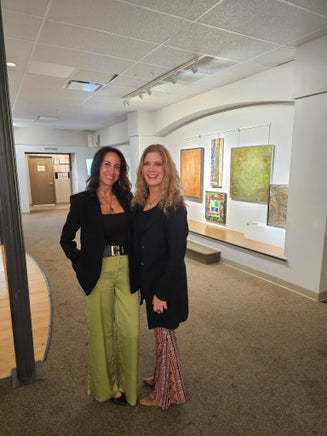


Freedom of Abstract
Amy was drawn to the art of abstraction for the freedom it offers when words fall short. She began early on experimenting with joint compound to build depth and dimension for its tactile impact and its accessibility. What started with basic acrylics evolved into her own sculptural style, where the canvas feels alive with movement and feeling. Her work often blurs the line between painting and sculpture, each piece telling a story through its layers, color, and ridges.
As a self-taught artist, Amy had no rulebook, so she wrote her own. She developed a style that reflects who she is rather than what the art world expects. Though her approach is not for everyone, she is proud of that. She never set out to blend in. She remains committed to standing out and sending a message, even when conformity would be easier. Her work carries a voice that is bold, imperfect, and deeply personal.
Over time, Amy has not only explored new mediums, but she has also developed original techniques and materials that coax a closer look, keep the viewer guessing, and transform each work into an ongoing conversation. Her practice traces an arc of evolution. Early pieces lean into heavy, hard textures and sculptural weight, while more recent paintings reflect what she has learned to create with a softer, smoother, more gentle touch. She did not recognize that shift at first. It revealed itself when she stood in the middle of an exhibition of hard and soft and realized she was looking at the evolution of her own life too, a narrative she had been subconsciously creating.
Much of Amy’s inspiration comes from nature, its shapes and colors, the way light shifts and changes, the slow creep of moss along forgotten paths. Nature is her refuge and mirror. It appears in the organic textures and earthy tones she reaches for and in the quiet evidence of healing that runs through the work.
At the same time, she weaves an industrial undertone through that natural language, echoes of old walls, bricks, rust, and weathered surfaces. Since childhood, Amy has loved the broken and abandoned: factories with shattered windows, paint chipped doors, forgotten corridors where time leaves a beautiful residue. She finds grace in decay, rhythm in fracture, and possibility in what has been left behind. That reverence for the imperfect becomes a tactile dialogue on the canvas, where mossy softness meets steel edged memory.
Amy is also known for writing deep, descriptive stories for every piece. Each painting holds a narrative, an emotional impression that gives meaning to the texture, and even the titles are intentional. As a child, her own name often felt like a missing piece, lost in the foster care system, shuffled around like files on a desk, reduced to a case number. Naming her pieces now is a profoundly personal act. Each title carries meaning, sometimes a memory, sometimes a message, the first whisper of the story the painting will tell.
Her work is a piece of her, Amy’s story shared with the world, layer by layer.

